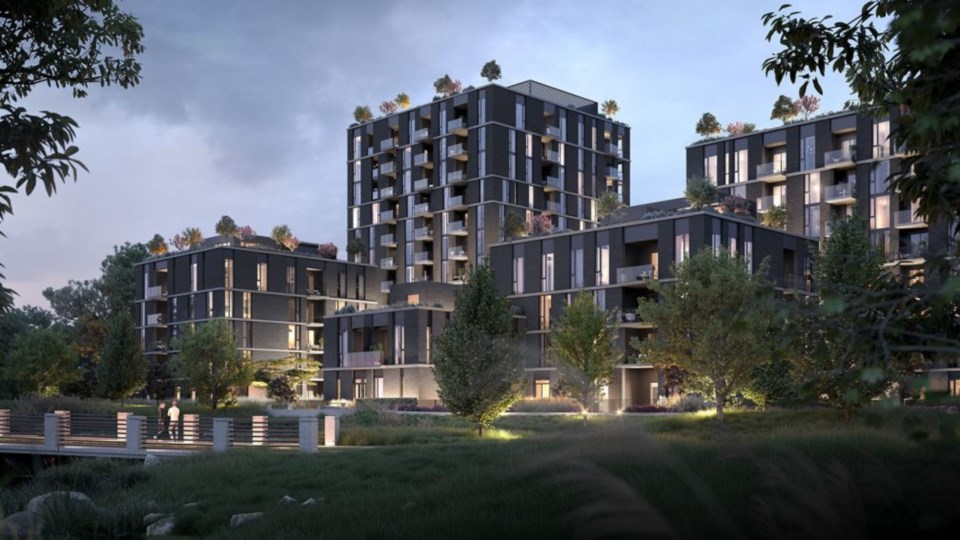A wider range of mortgage options are returning to the market, 16 years after the Great Recession and global financial crisis prompted Ottawa to rein in longer amortizations and tighten lending criteria.
A change to the rules announced earlier this year took effect Aug. 1, allowing first-time home buyers to buy a newly built home with a down payment of less than 20 per cent on a 30-year mortgage and obtain federal mortgage insurance through the Canada Mortgage and Housing Corp.
Thirty-year mortgages have been offered for several years but haven’t been eligible for insurance since 2012.
Meanwhile, 35-year mortgages are being offered on presales at Wesgroup Properties’ River District project in South Vancouver through a so-called “green home” mortgage from RBC Royal Bank.
The option is available to qualifying buyers in the Harlin and Ardea developments, which together have 537 units and feature “thermally enhanced insulation and window walls, a high-efficiency energy recovery ventilator, and hybrid heat pumps connected to a low-carbon district energy system.” The units are expected to be 10 per cent more energy efficient than B.C. Building Code requirements.
“It’s a way to put homeownership within reach,” said Jennifer Hamdon, sales operations manager with Wesgroup. “The interest rates that we’re seeing right now is making it a challenge for so many people to get their foot in the door.”
Sustainability has long been a focus of Wesgroup’s approach at River District, and mortgages that incentivize energy-efficient housing choices support both its own goals and those of prospective purchasers.
“It totally fit within our sustainability focus, but it also helped to provide our purchasers with another option to help become a homeowner because as we know in this climate it’s challenging,” Hamdon said.
Lenette Birdsell, senior director, national builder markets at RBC, works with developers to offer the green home mortgages, and says it shows how addressing changing climate and affordability can work in sync. RBC is working with 70 builders nationwide to offer the mortgages.
“The RBC Green Home mortgage is really making owning a more energy-efficient home acceptable, with lower mortgage payments,” she said. “Any time you reduce heating costs and you amortize it over a longer period of time, it’s definitely going to help affordability.”
The green mortgage option is part of RBC’s efforts to support Canada’s commitment to achieve a 37 per cent reduction in greenhouse gas emissions from buildings versus 1990 by 2030. Introduced in January, it’s currently the only one of its kind available in Canada.
Qualifying projects may include one or more of the following features: high R-value insulation, high-efficiency windows and doors; smart and energy-efficient lighting; onsite renewable energy generation; and programmable, high-efficiency heating and cooling systems.
A conventional 25-year amortization is possible, as well as 30 and 35-year options.
RBC isn’t the only lender offering longer mortgage terms.
Equitable Bank introduced a 40-year uninsured mortgage to Canada last fall, an option hailed as allowing for reduced payments in a difficult market.
However, as an uninsured mortgage, the interest rate is higher. Moreover, if the loan ran for the full 35 years, the total interest paid would be significantly greater.
Wesgroup indicates that buyers of a $668,850 one-bedroom unit would pay $404 less a month with a 35-year amortization versus a 25-year amortization. However, interest costs over the full amortization period could be as much as 60 per cent higher.
The new financing options hearken back to 2006, when CMHC began insuring mortgages with amortizations of 30, 35 and 40 years as well as interest-only and zero-down mortgages.
The relaxation in rules was short-lived. The sub-prime crisis in the U.S. and emerging risks to the financial system in 2008 prompted CMHC to change course.
It shortened amortization periods to 35 years in 2008 then 30 years in 2011 and finally back to traditional 25-year amortizations in 2012. Down payment requirements also changed, and criteria such as credit scores and stress-testing of borrowers were tightened.
The moves addressed concerns about an over-heated housing market and speculation, trumping those regarding housing affordability. The rules have remained largely unchanged since.



